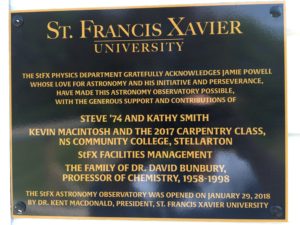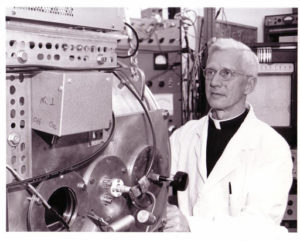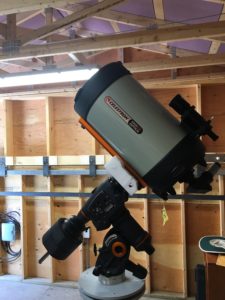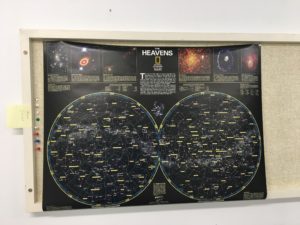This article, written by Philip Girvan, StFXAUT Communications Officer, appears in the Summer 2018 edition of The Beacon.

Maintaining a permanent public observatory on the StFX University campus has been a challenge. The first to attempt to get one established was the Reverend Doctor E.M. Clarke, credited with initiating the physics research program at StFX under the guidance of the then President, the Right Reverend Monsignor Doctor P. J. Nicholson, who was also a physicist. Dr. Michael Steinitz, Professor Emeritus with the Physics Department, told The Beacon that Clarke purchased telescopic equipment and a dome out of his own pocket, but could not convince StFX University administration to allow an observatory to be built on campus, and the equipment sat, unused, in an attic in the science building for years.

Permission to build an observatory was finally granted following Steinitz’s appointment as Chair of the Physics Department. As Steinitz tells it, this was secured only after a heated confrontation with the then University Academic Vice-President J. J. MacDonald. University administration finally agreed to provide space and allocate the funds necessary to construct an observatory. This work was performed by carpenters with StFX Facilities Management. The Clarke Observatory, built on the roof of the old Science Building, the current Schwartz School of Business, opened during the 1979-80 academic year. While the observatory was being built, Dr. Clarke was receiving care for his terminal cancer in the infirmary, then located on the top floor of Morrison Hall. Though Clarke was never able to visit the observatory, he watched the observatory’s progress from his bed, and saw most of it completed just before he died. In addition to training students, the Clarke Observatory held weekly public viewing sessions throughout the academic year. These attracted significant interest. Jamie Powell, Senior Lab Instructor with the StFX University Physics Department, took over the operation of the observatory in 1990. The observatory was well used. For example, around a hundred people queued to view Comet Hyakutake in 1996 and Comet Hale-Bopp in 1997.
Free, public rooftop observations came to an end once StFX began transforming the science building into The Schwartz School of Business. Telescopic equipment was moved to the Physical Sciences Centre in 2004, and lugged out to be set up whenever a significant stellar event would take place. Since the dismantling of the Clarke Observatory, there has been a decade-long community effort to re-establish a public observatory. Powell has been the driving force behind this.
“That has occupied a lot of my time,” Powell admitted, “trying to get the observatory back”.

Powell emphasized to The Beacon his belief that community outreach is key to the university mission: “Having a resource to use seems to me at least one of the functions of a University: to engage the public in culturally significant things, scientific things”. This belief has informed Powell’s outreach efforts which include, among others, his role in the establishment of the Harbour Sky Astronomical Club, a shared partnership between the Fresh Air Society and the StFX Physics Department; his involvement organizing physics exhibits at the annual MayFest fundraiser; and his participation in week long summer camps involving students from the Chignecto School Board with personnel from other science departments. All these community efforts have been critical toward the promotion of the marvels of physics to Antigonish, as well as the broader Nova Scotia community.
One of Powell’s outreach activities provided at least a temporary solution to the closing of the Clarke Observatory. He was providing astronomy lessons to enrollees of the Free Play program being run by Frank Gallant, and approached Frank and Heather Gallant regarding their Lanark property to see whether they would agree to “put the telescope out there in Lanark and use the refurbished dome and do outreach there” as Powell put it.
The Gallants agreed and construction began. This work involved considerable community mobilization. Individual contributions from the Gallants as well as Dr. Michael Brennan and Dr. Roger Porter covered costs related to the site’s construction. Arsenault Monuments provided a truck to transport the dome from the roof of the old Science Center to Lanark. Volunteer labour was provided and involved landscaping the site, digging a hole for a cement footing, installing a steel pipe for the telescope to sit on, relocating a large deck as a base for the dome, rebuilding walls to support the dome, and, finally, raising and placing the dome.
A new telescope was secured in the spring of 2010 via a Service Learning Faculty Development and Research Support Fund grant: the Community-based Astronomy Education and Outreach awarded to Dr. Shah Razul and Powell. This was installed in the Lanark space in the fall of 2010. The Clarke Astronomical Observatory Dome began supporting students enrolled in the newly created StFX Physics department astronomy courses PHYS171, Introduction to Astronomy I, and PHYS172, Introduction to Astronomy II. Students facilitated the public viewings that served as part of the courses’ Service Learning components.
Problems quickly began to arise. The Lanark location had no electricity. “We were running things manually,” Powell recalled. In the spring of 2012, Dr. Frank Comeau with the Engineering Department, Dr. Peter Poole with the Physics Department, and Powell wrote a successful Service Learning grant to buy solar panels and batteries to power the observatory.
The final, fatal snag involved insurance. In order to protect both the University and the Gallants from liability issues, the two parties entered into a land-use agreement. Powell considered the financial burden to the Gallants prohibitive. He told The Beacon that, “I wanted to end that arrangement because the cost to them made no sense to me. I wanted to be sure that we stopped it before they had to say no”. As a result, the observatory was abandoned. The dome sits on the Gallants’ property to this day. Powell removed the telescope and moved it back to the Physical Sciences Centre and, once again, began carrying it out to the back of the building for observing sessions.
Potential spots to locate the observatory off-campus continued to be sourced. These were ultimately unsuccessful. Around 2014, Powell began scouting locations on campus. At this time, both the university and the Physics Department were feeling a financial pinch, and Powell recognized that “whatever we did had to be done at essentially zero cost. There were no resources”.
Wendy Morse, Manager of Procurement Services suggested that Powell contact the Nova Scotia Community College. Powell reached out to Kevin MacIntosh, faculty with the NSCC Pictou Campus Carpentry Diploma Program. MacIntosh noted to The Beacon that the carpentry program “is geared toward entry level construction”. Carpentry students are expected to complete two work terms which involve applying knowledge and skills to a construction project. Typical projects, according to MacIntosh, would include “baby barns, group homes, miniature or downsized housing”. Powell was proposing a unique and interesting challenge. MacIntosh and Powell met at the NSCC and scribbled some notes. Following this initial meeting, MacIntosh felt that this “looked like a very nice opportunity for the community college to work with the university”.
Powell met the students and provided them with dimensions that would allow advantageous lines of sight. The rest was up to them. MacIntosh emphasized that no architect or engineer guided this work and, while students don’t “typically take ownership of the design,” he described the class as “relentless” to see this through.
There was still a matter of sourcing building materials. Powell reached out to Steve and Kathy Smith, then still owners of Central Building Supplies, who graciously agreed to donate building supplies.
Construction began in January 2017. The building was completed in April, but yet another challenge arose. The observatory was to have been built behind the student apartments located on West Street. However, during the summer of 2017, Powell was informed that these were being torn down. The West Street location, with its space for parking, its washroom, its proximity to campus, was, in many ways, ideal. Powell noted that it had “a light rise in ground and we would be allowed to have one of the West Street apartments as our storage area, and what I would call a warm room”.
A warm room was critical. An observatory cannot be heated due to the sensitivity of the instruments. Astronomy is what Powell termed “a low energy activity” that involves a lot of waiting and being still. As a result, astronomers require a space to warm up as the temperature drops.

The Dean of Science, Dr. Petra Hauf, arranged for a small structure to be built in the West Street location. This provided classroom space and storage. Over the summer of 2017, electrical wiring was installed and, during the fall, Powell, along with physics students Heather MacIsaac, Patrick O’Brien, and Liam Farrell began commissioning the two telescopes to ensure that they were aligned. The solar panels and batteries from the Lanark site were installed on and in the classroom.
The grand opening of the StFX Observatory that took place on January 29, 2018, was the culmination of a decade-plus long community effort. Powell emphasized to The Beacon that:
What’s impressed me about all this has been the cooperation between various parties: administration, the Physics Department, NSCC, Facilities Management, the Dean [of Science], private individuals like Steve Smith coming together. Iain Boyd has been in this helping to liaise with donors. Getting all of this together, and coordinated, and made, and put up. It’s been rewarding to see this level of cooperation.
Public observing sessions at the observatory will be held Monday and Wednesday evenings starting September 17th, weather permitting. For more details on dates and times, please visit the StFX Department of Physics Facebook page , or webpage, or contact Jamie at jpowell[at]stfx[dot]ca
___________________________________________________________
Further reading:
“StFX Observatory officially opens”. StFX News. https://www.stfx.ca/about/news/observatory-opens last accessed September 16, 2018.
Harbour Sky Astronomy Club. Fresh Air Society. Sustainable Antigonish. http://sustainableantigonish.ca/community-initiatives/fresh-air-society/harbour-sky-astronomy-club/ last accessed September 16, 2018.
Steinitz, M.O. “The Little Physics Department That Could (The History of St. F.X….). Physics in Canada. March/April, 1999. https://forms.cap.ca/temp_PiC_archive/1999-v55-n2.pdf last accessed September 16, 2018.
